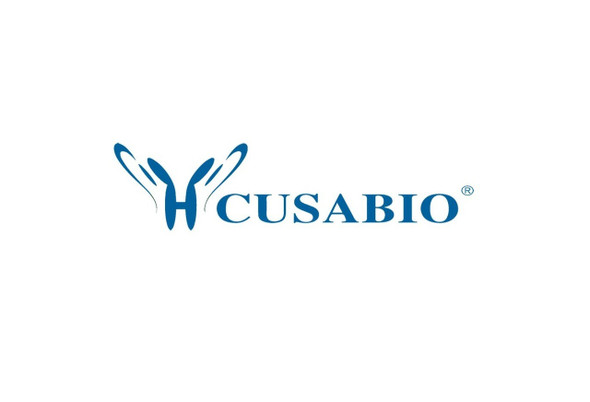Cusabio Human Recombinants
Recombinant Human 5'-AMP-activated protein kinase subunit gamma-2 (PRKAG2) | CSB-EP887021HU
- SKU:
- CSB-EP887021HU
- Availability:
- 13 - 23 Working Days
Description
Recombinant Human 5'-AMP-activated protein kinase subunit gamma-2 (PRKAG2) | CSB-EP887021HU | Cusabio
Alternative Name(s): H91620p
Gene Names: PRKAG2
Research Areas: Cardiovascular
Organism: Homo sapiens (Human)
AA Sequence: MLEKLEFEDEAVEDSESGVYMRFMRSHKCYDIVPTSSKLVVFDTTLQVKKAFFALVANGVRAAPLWESKKQSFVGMLTITDFINILHRYYKSPMVQIYELEEHKIETWRELYLQETFKPLVNISPDASLFDAVYSLIKNKIHRLPVIDPISGNALYILTHKRILKFLQLFMSDMPKPAFMKQNLDELGIGTYHNIAFIHPDTPIIKALNIFVERRISALPVVDESGKVVDIYSKFDVINLAAEKTYNNLDITVTQALQHRSQYFEGVVKCNKLEILETIVDRIVRAEVHRLVVVNEADSIVGIISLSDILQALILTPAGAKQKETETE
Source: E.coli
Tag Info: N-terminal 6xHis-tagged
Expression Region: 1-328aa
Sequence Info: Full Length of Isoform B
MW: 41.5 kDa
Purity: Greater than 90% as determined by SDS-PAGE.
Relevance: AMP/ATP-binding subunit of AMP-activated protein kinase (AMPK), an energy sensor protein kinase that plays a key role in regulating cellular energy metabolism. In response to reduction of intracellular ATP levels, AMPK activates energy-producing pathways and inhibits energy-consuming processes: inhibits protein, carbohydrate and lipid biosynthesis, as well as cell growth and proliferation. AMPK acts via direct phosphorylation of metabolic enzymes, and by longer-term effects via phosphorylation of transcription regulators. Also acts as a regulator of cellular polarity by remodeling the actin cytoskeleton; probably by indirectly activating myosin. Gamma non-catalytic subunit mediates binding to AMP, ADP and ATP, leading to activate or inhibit AMPK: AMP-binding results in allosteric activation of alpha catalytic subunit (PRKAA1 or PRKAA2) both by inducing phosphorylation and preventing dephosphorylation of catalytic subunits. ADP also stimulates phosphorylation, without stimulating already phosphorylated catalytic subunit. ATP promotes dephosphorylation of catalytic subunit, rendering the AMPK enzyme inactive.
Reference: "CBS domains form energy-sensing modules whose binding of adenosine ligands is disrupted by disease mutations."Scott J.W., Hawley S.A., Green K.A., Anis M., Stewart G., Scullion G.A., Norman D.G., Hardie D.G.J. Clin. Invest. 113:274-284(2004)
Storage: The shelf life is related to many factors, storage state, buffer ingredients, storage temperature and the stability of the protein itself. Generally, the shelf life of liquid form is 6 months at -20?/-80?. The shelf life of lyophilized form is 12 months at -20?/-80?.
Notes: Repeated freezing and thawing is not recommended. Store working aliquots at 4? for up to one week.
Function: AMP/ATP-binding subunit of AMP-activated protein kinase (AMPK), an energy sensor protein kinase that plays a key role in regulating cellular energy metabolism. In response to reduction of intracellular ATP levels, AMPK activates energy-producing pathways and inhibits energy-consuming processes
Involvement in disease: Wolff-Parkinson-White syndrome (WPWS); Cardiomyopathy, familial hypertrophic 6 (CMH6); Glycogen storage disease of heart lethal congenital (GSDH)
Subcellular Location:
Protein Families: 5'-AMP-activated protein kinase gamma subunit family
Tissue Specificity: Isoform B is ubiquitously expressed except in liver and thymus. The highest level is detected in heart with abundant expression in placenta and testis.
Paythway: Adipocytokinesignalingpathway
Form: Liquid or Lyophilized powder
Buffer: If the delivery form is liquid, the default storage buffer is Tris/PBS-based buffer, 5%-50% glycerol. If the delivery form is lyophilized powder, the buffer before lyophilization is Tris/PBS-based buffer, 6% Trehalose, pH 8.0.
Reconstitution: We recommend that this vial be briefly centrifuged prior to opening to bring the contents to the bottom. Please reconstitute protein in deionized sterile water to a concentration of 0.1-1.0 mg/mL.We recommend to add 5-50% of glycerol (final concentration) and aliquot for long-term storage at -20?/-80?. Our default final concentration of glycerol is 50%. Customers could use it as reference.
Uniprot ID: Q9UGJ0
HGNC Database Link: HGNC
UniGene Database Link: UniGene
KEGG Database Link: KEGG
STRING Database Link: STRING
OMIM Database Link: OMIM










